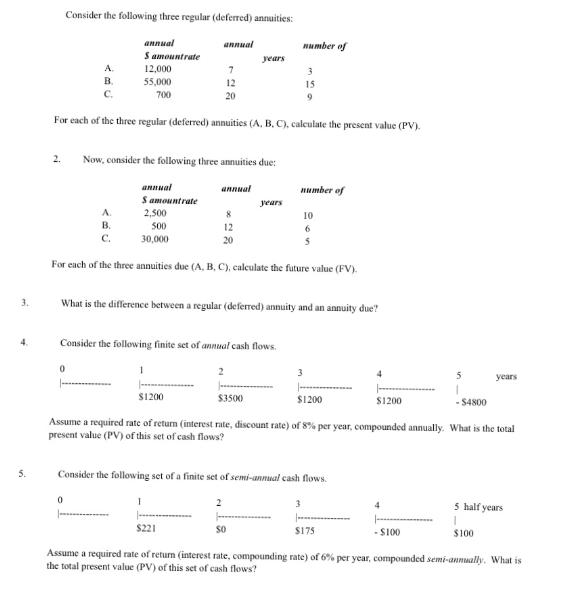Answered step by step
Verified Expert Solution
Question
1 Approved Answer
3. 4. 5. 2. Consider the following three regular (deferred) annuities: A. B. C. 0 annual S amountrate 12,000 55,000 700 A B. C.

3. 4. 5. 2. Consider the following three regular (deferred) annuities: A. B. C. 0 annual S amountrate 12,000 55,000 700 A B. C. For each of the three regular (deferred) annuities (A, B. C), calculate the present value (PV). 0 annual Samountrate 2,500 500 30,000 Now, consider the following three annuities due: annual 7 12 20 $1200 annual 1 8 12 20 Consider the following finite set of annual cash flows. 1 years For each of the three annuities due (A, B, C), calculate the future value (FV). 2 What is the difference between a regular (deferred) annuity and an annuity due? $3500 2 years number of 3 15 9 number of SO 10 6 3 Consider the following set of a finite set of semi-annual cash flows. $1200 - $4800 Assume a required rate of return (interest rate, discount rate) of 8% per year, compounded annually. What is the total present value (PV) of this set of cash flows? 3 $1200 $175 4 5 years $221 Assume a required rate of return (interest rate, compounding rate) of 6% per year, compounded semi-annually. What is the total present value (PV) of this set of cash flows? -$100 5 half years 1 $100
Step by Step Solution
★★★★★
3.45 Rating (152 Votes )
There are 3 Steps involved in it
Step: 1
Lets tackle each question step by step For question 1 we need to calculate the present value PV of the three regular deferred annuities The present va...
Get Instant Access to Expert-Tailored Solutions
See step-by-step solutions with expert insights and AI powered tools for academic success
Step: 2

Step: 3

Ace Your Homework with AI
Get the answers you need in no time with our AI-driven, step-by-step assistance
Get Started


